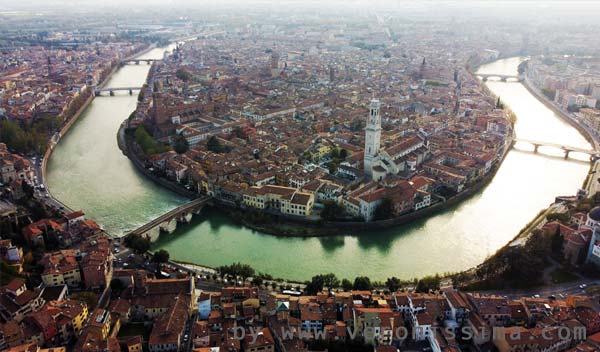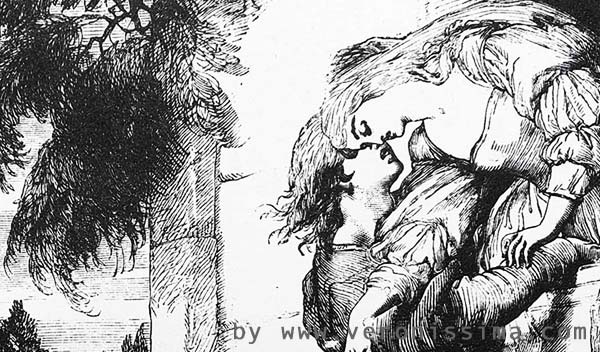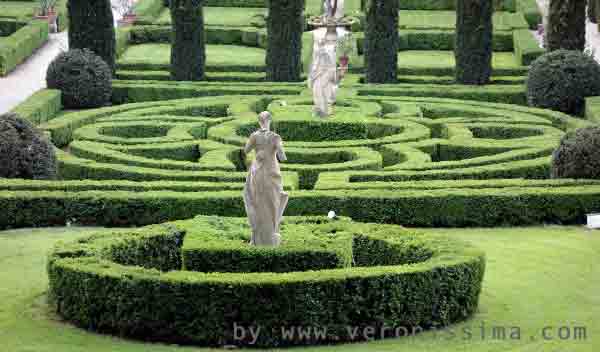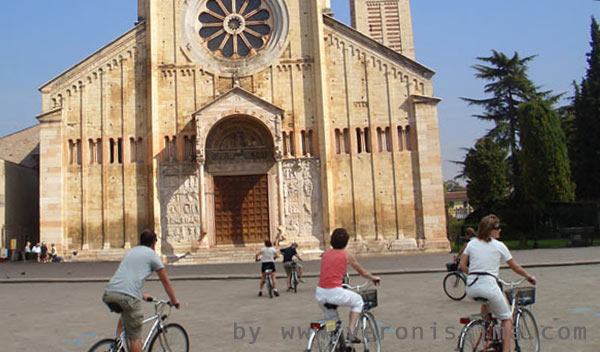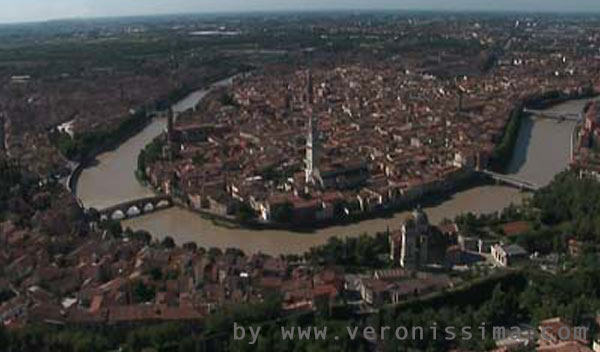Paolo Veronese in Verona
Guided tours to discover the Verona of Paolo Veronese, its most famous artist.
Discover the sumptuous Venetian sixteenth century culture in Verona among churches and museums that house his works and other fascinating, unknown places in the city.

A guided tour of Verona that is a true exhibition spread throughout the city and will allow you to learn more about the life and artistic world of Paolo Caliari, known as Il Veronese. Ideal for lovers of art, history and alternative routes to the usual tourist itineraries.
Bookings and info:
+39 333 2199 645 info@veronissima.com P.I. 03616420232 C.F. CPPMHL74L13L781C
Itinerary 1: l'Isolo (the Island) and St Paul
- Half day
- 2h.
- Accessibility
- Accesses to specific areas within the churches have differences in height and steps.
Trail Route: Giarina park > St Anastasia, Ponte Pietra bridge, Roman Theater (all outdoor) > Isolo square > St Maria in Organo churhc > St Thomas > via Scrimiari > Marogna palace > St Paul church.

The church of St Paul in Campo Marzio in Verona. Inside is the Marogna altarpiece by Paolo Veronese.
Paolo Veronese was born in 1528 in contrada San Paolo, on the left bank of the Adige, outside the heart of the Roman city but always a place rich in history and tradition. Until 1882, the area was characterized by a large river island, rich in artisanal and artistic activities that used the river as a driving force for mills and transportation. It was here that Paolo Veronese received his first artistic training, first from his father, a stonemason and sculptor, and then in the workshop of Antonio Badile. It was here that he met the architect Michele Sanmicheli whose studio was near the church of San Tommaso, in the heart of the Isolo.

Michele Sanmicheli, a Renaissance architect in Verona.
FIND OUTSanmicheli became one of the main patrons of the young painter, providing him with his first important commissions in the Venetian circle where, thanks to his works for the Serenissima, he was very well connected.

After the great flood of 1882 and the construction of the embankments, the branch of the river that deviated from the main course giving life to an island (Isolo in Italian) was filled in. The look of one of the most charming areas of the city was thus radically modified. In 1888, a statue of Paolo Veronese by the sculptor Torquato Dalla Torre was placed right where the Adige forked giving life to the Isolo.
The Isolo is off the beaten track in Verona. However, together with Verona tour guides, it will become the destination of an evocative tour in search of the old 16th century city and the roots of Paolo Veronese. From the left bank of the Adige you will enjoy unusual views of ponte Pietra bridge (first century), the Roman Theater overlooked by the Colle San Pietro hill and castle, on Bra dei Molinari square, where crowded the many floating mills used for grinding natural pigments, the Church of Santa Anastasia, Santa Maria in Organo and San Tommaso, the latter with important works of Michele Sanmicheli.
Inside the church of San Paolo in Campo Marzio, one of the few works Paolo Caliari painted for his city is preserved, half-hidden in a side chapel: the Pala Marogna.From San Paolo it is easy to reach the paint factori Dolci, one of the few in Italy that still works with natural minerals to produce pigments using sixteenth-century techniques. A visit with an in-depth study of Veronese colors is possible. Ideal for a school trip.
Itinerary 2: Veronese inside churches
- Half day
- 2h.
- Accessibility
- Some entrance requires payment of a ticket. Some specific areas inside churches have steps and gaps.
Itinerary: Santa Anastasia church > San Giorgio in Braida church > San Paolo in Campo Marzio churcch > Marogna Palace (outside).

This tour will take you to discover the only two works of Paolo Veronese still preserved in the churches of Verona: the intense St George Martyrdom in San Giorgio in Braida church and the almost unknown Pala Marogna "hidden" in San Paolo in Campo Marzio church. San Giorgio in Braida also features an important intervention of the renaissance architect Michele Sanmicheli with the elegant dome and bell tower.

The "Hunchback" of St. Anastasia
Inside the church of Santa Anastasia we will go in search of the "origins" of Paolo Veronese. One of the sculptures of the "hunchbacks" that hold up the stoups of Sant'Anastasia has always been attributed to Paolo Veronese's father, a stonemason and sculptor. Although the attribution is doubtful, we know that Paolo Veronese's father actually worked on the Santa Anastasia building site just as Antonio Badile was decorating the Boldieri altar. It is not difficult to imagine him talking about his son's talent and asking Badile, who was a well known painting master in Verona, to take him into his workshop.
Not far away, on Corso Santa Anastasia street, there was the ancient church of Santa Cecilia, where Paolo Veronese married Elena, the master's daughter. The church no longer exists, but its bell tower and a Roman tombstone that was used in the facade remain.
Itinerary 3: Castelvecchio
- Half day
- 2h.
- Accessibility
- The art gallery where Paolo Veronese's works are exhibited is accessible by elevator. An entrance fee is required.
Castelvecchio museum in Verona exhibits three works by Paolo Veronese.

The Deposition is an early work with bright colors and a typical theatrical setting. The extraordinary technical skills and amazing stylistic innovations that are characteristic of Veronese are already evident.

Bevilacqua Lazise altarpiece
The Pala Bevilacqua Lazise was originally located in a side chapel of San Fermo church. It presents the typical triangle structure with the Madonna at the vertex sitting on ancient architecture structure, and the saints at the side corners. A colorful parrot is almost a "signature" of the master who often put exotic animals in his paintings. He was questioned about this in the famous inquisitorial trial he underwent because of his "Last Supper".
Inside the Castelvecchio picture gallery there are also works by artists from Veronese's era that allow us to contextualize his work within the artistic panorama of Verona during the Renaissance.
Itinerary 4: Theatrical Tour
- Half day
- 2h.
- Accessibilty
- Some specific areas inside churches have steps and gaps.
At the moment only available in Italian.

A walk through the streets of the Isolo with Paolo Veronese himself. A professional theatrical actor will interpret the great Renaissance painter by talking about his time through the streets of the city that saw him as a child and young apprentice. The walk will end at San Paolo in Campo Marzio church where, in front of the Marogna altarpiece "Paolo Veronese" will talk about the trial to which he was subjected by the Inquisition precisely because of one of his works.
Ideal tour for school groups on a school trip to Verona.
Info & bookings
+39 333 2199 645 info@veronissima.com P.I. 03616420232 C.F. CPPMHL74L13L781C
Paolo Caliari the Veronese: biographical notes
 Paolo Caliari was born in Verona, in the district of San Paolo, in 1528. His father Gabriele was a stonemason, a stone cutter with some artistic ability. According to tradition is his work one of the two statues that support the stoups of the church of Santa Anastasia. Showing strong and precocious artistic skills, the young Paolo was sent to the workshop of Antonio Badile, whose daughter Elena he later married.
Paolo Caliari was born in Verona, in the district of San Paolo, in 1528. His father Gabriele was a stonemason, a stone cutter with some artistic ability. According to tradition is his work one of the two statues that support the stoups of the church of Santa Anastasia. Showing strong and precocious artistic skills, the young Paolo was sent to the workshop of Antonio Badile, whose daughter Elena he later married.
Paolo Caliari proved from the beginning attracted by the new Mannerist style that was spreading with increasing success thanks to the work of Giulio Romano in Mantua. Thanks to the protection of Michele Sanmicheli, one of the most famous and influential Renaissance architects not only in Verona but throughout the Veneto region, Paolo Caliari began to be known and receive increasingly important commissions until he landed in Venice. Arrived in the rich and sumptuous capital of what was then a vast state, Paolo Caliari was nicknamed "il Veronese" and started to achieve the success that made him one of the most famous and rich artists of the lagoon. There were numerous commissions, both public and private: the ceiling of the Marciana library, the cycle of frescoes for Villa Barbaro by Palladio, the great and famous 'dinners', until the triumph consecrated with the commission of paintings for the Palazzo Ducale.
An important feature of the art of Paolo Veronese is undoubtedly represented by his relationship with architecture and the decorative arts, a very important relationship that the painting of Paolo Veronese established with the Renaissance. The painter was in fact a protagonist of the art of his time thanks to close collaboration with architects such as Michele Sanmicheli and Andrea Palladio, masters of the new style that was inspired by the remains of the Roman past in which his native Verona has always been rich. Paolo Veronese was in fact a great representer of Renaissance architecture. His subjects are often set within colonnades surmounted by elaborate balustrades, the figures sit on pillars and staircases that create daring perspectives, and not infrequently the background is made up of veritable galleries of neoclassical palaces.
A great sensuality emerges from Paolo Veronese's works, especially in those with mythological themes. It was also these subjects that made Paolo Veronese famous among his contemporaries and subsequently beloved by posterity. In paintings such as Perseus and Andromeda, the Allegories of Love now at the National Gallery or Mars and Venus (from the Galleria Sabauda), Paolo Veronese's ability to evoke in his paintings the fantastic atmospheres of myth and sensuality emerges, borrowing them from a Venice at the height of its power and splendor. The chronicles of the time tell of how the painter's studio was filled with precious fabrics, refined objects, armor, and jewelry frequented by the sensual models who contributed to creating the fantastic worlds represented in his canvases.
Veronese's success was due above all to the very high quality of his painting and his originality, which differentiated him from painters trained in Venice. If, on the one hand, the Renaissance in the lagoon had privileged color and chiaroscuro, Veronese, on the other hand, had always maintained a great attention to the cleanliness and definition of the drawing typical of the models of central Italy. His majestic works were characterized by a sumptuous theatricality and a careful rendering of the preciousness of the fabrics, furnishings, and clothing, elements that were much appreciated by the rich Venetian patrons.
With his artistic maturity, Paolo Veronese achieved fame and wealth, becoming one of the most sought-after artists in Venice, with prestigious public, private and religious commissions. There will be some portraits of Venetian nobles including the famous "Bella Nani" drawings and oils celebrating Venice as the "Allegory of the Battle of Lepanto" or a study for Venice on the Throne.
The Inquisition Trial
In the course of his life, Paolo Veronese also had to deal with the Inquisition, which tried him because of one of his paintings with unusual and original content that made him suspect heresy. Famous is the transcript of his interrogation in which the painter speaks of his freedom as an artist with feigned naivety and ill-concealed sarcasm:
We fellow painters take the liberty that poets and madmen take.
Paolo Caliari returned several times to his hometown, receiving some commissions, although now, considered a foreign artist, his style was partly snubbed by the Veronese patrons who sought to differentiate themselves, at least in the artistic field, from the capital Venice. His works are still preserved in the church of San Giorgio, "The Martyrdom of St. George" and in San Paolo, the church in the neighborhood where he was born and raised with the "Pala Marogna".
Paolo Veronese died in 1588 in Venice. He is buried in Venice, in the church of San Sebastiano, surrounded by his works.



The artistic legacy was carried on by the work of students and relatives who continued the pictorial language. In this context was made the impressive restoration of "La cena a Casa di Levi", from Palazzo Barbieri, the seat of the municipality of Verona, and that, while remaining the work of the so-called Haeredes Pauli, a sort of "consortium" of the brother and two sons of Veronese, almost certainly takes up ideas, designs, personality of the master.
Further information and bookings:
+39 333 2199 645 info@veronissima.com P.I. 03616420232 C.F. CPPMHL74L13L781C

 IT
IT 日本
日本 DE
DE FR
FR 中文
中文 ES
ES